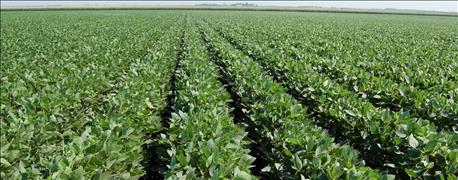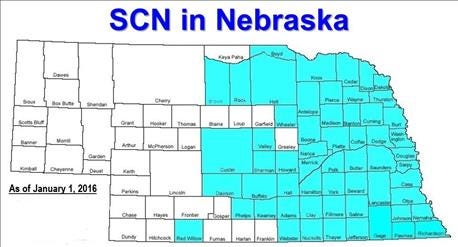March 7, 2016

By John Wilson and Loren Giesler
Eleven years ago the Nebraska Soybean Board started what has become an extremely successful program to provide free soil analysis for soybean cyst nematodes (SCN) in Nebraska. SCN is the most devastating pest to US soybean growers. Last year SCN cost Nebraska farmers about $40 million and nationally over $1.5 billion in lost yields.
It started slowly, but has grown to more than 7,650 samples being processed by the UNL Plant Pathology department, almost one-third of which were positive for SCN.
For the third consecutive year, over 1,000 soil samples were processed from Nebraska growers.

SCN TESTING: Eleven years ago the Nebraska Soybean Board started what has become an extremely successful program to provide free soil analysis for SCN in Nebraska. It started slowly, but has grown to more than 7,650 samples being processed by the UNL Plant Pathology department, almost one-third of which were positive for SCN. For the third consecutive year, over 1,000 soil samples were processed from Nebraska growers.
In the 19 years prior to the sampling program SCN had been identified in only 27 counties. Since then it has been identified in another 31 counties. In many cases farmers had not suspected SCN prior to submitting soil samples.
This illustrates why it's so important to test fields for SCN. This program more than doubled the rate at which SCN was confirmed across the state.
SCN losses can be reduced if a farmer knows it's in a field – but that's the catch. Farmers can have yield losses of 20% to 30% with no visible symptoms on the plant. Often the first indication of an SCN infestation is when soybean yields plateau or even start to drop off, while corn yields continue to increase in that field.
Nebraska Soybean Board sponsored SCN soil tests
The best way to determine if SCN is in a field is to take a soil test. Nebraska Soybean Board's support covers the cost of analyzing soil samples for SCN, normally a $20 per sample expense. Without the Nebraska Soybean Board's support, we would not have been able to reach this many Nebraska farmers.

Figure 1. Lab-confirmed distribution of soybean cyst nematode (SCN) in Nebraska as of Jan. 1, 2016.
Based on the last year's SCN soil tests results, we are announcing the 7th Annual 'Tode Award winners.
In the category of Most Samples Submitted:
• Winner: Buffalo County (187)
• Honorable Mentions: Boone (64); Kearney (53); Phelps (50)
In the category of Most Samples Positive for SCN:
• Winner: Buffalo County (46)
• Honorable Mention: Antelope (25); Madison (17); Seward (16)
In the category of Highest Percentage of Samples Positive for SCN: (must have submitted at least five
samples)
• Winner: Rock County (71%)
• Honorable Mention: Antelope County (64.1%); Seward (64.0%); Richardson (60%)
In the category of Sample with Highest Egg Count: (number of eggs/100 ccs of soil)
• Winner: Antelope County (75,960)
• Honorable Mention: Wheeler (36,240); Kearney (31,520); Pierce (21,200)
And finally, in the category of Counties with First SCN Detection the winner is Brown.
Some might argue that the county in the last category is a loser, not a winner. However, now farmers in Brown County know SCN has been found in area fields so they can sample for it and start managing it if found.
Although it often goes undetected, SCN is here and it is reducing profitability for Nebraska soybean producers. To learn more about SCN or to pick up bags to submit soil samples, contact your local Nebraska Extension office.
Wilson is a UNL Extension educator
Giesler is a UNL Extension plant pathologist
Source: UNL CropWatch
You May Also Like




